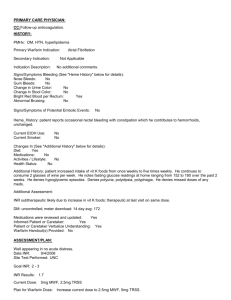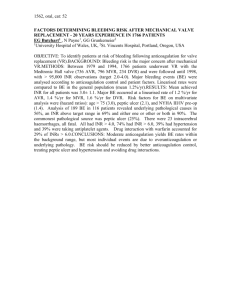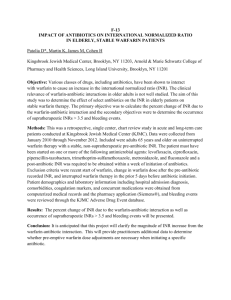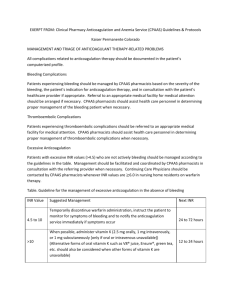OXFORD HAEMOPHILIA AND THROMBOSIS CENTRE PROTOCOLS
advertisement
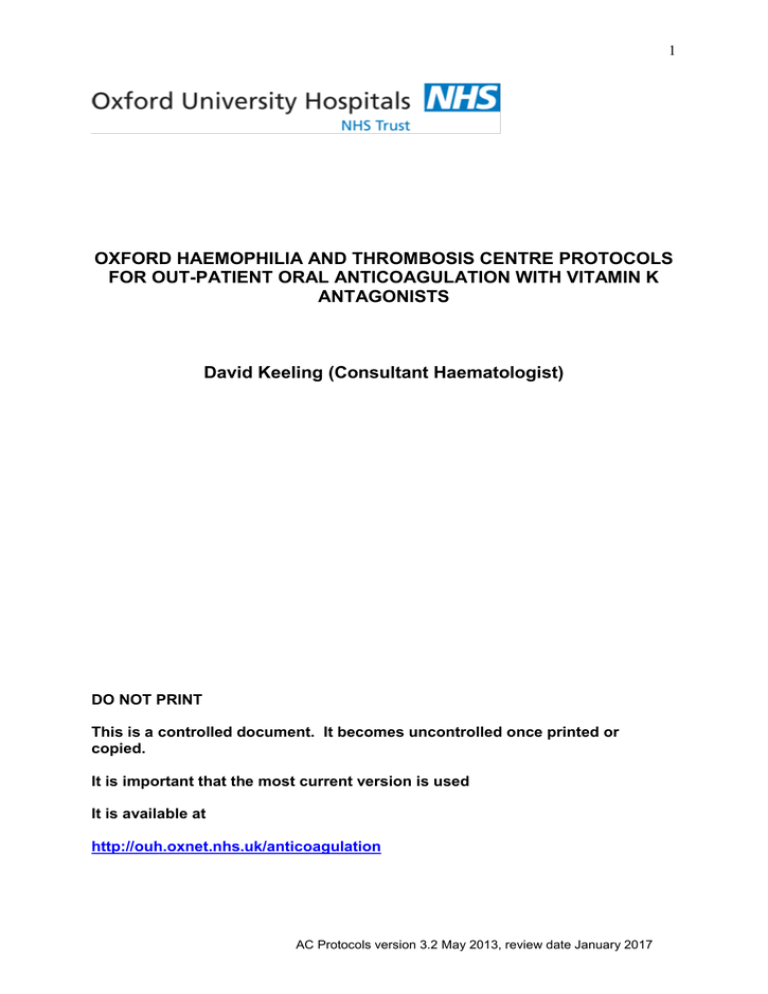
1 OXFORD HAEMOPHILIA AND THROMBOSIS CENTRE PROTOCOLS FOR OUT-PATIENT ORAL ANTICOAGULATION WITH VITAMIN K ANTAGONISTS David Keeling (Consultant Haematologist) DO NOT PRINT This is a controlled document. It becomes uncontrolled once printed or copied. It is important that the most current version is used It is available at http://ouh.oxnet.nhs.uk/anticoagulation AC Protocols version 3.2 May 2013, review date January 2017 2 Contents Indications and target INR Atrial fibrillation and cardioversion Heart valve prostheses 3 3 4 Duration of treatment in venous thromboembolism 6 Commencement of oral anticoagulant therapy Standard induction regimen commenced with heparin cover Slow induction of anticoagulation in patients with atrial fibrillation without heparin cover 6 6 7 Management of anticoagulation in the peri-operative period for major surgery or procedure where the INR has to be ≤1.3 Dentistry Endoscopy 8 9 9 Management of bleeding and high INR in the absence of bleeding Major bleeding Non-major bleeding High INRs in non-bleeding patients 11 11 11 12 Management of sub-therapeutic anticoagulation 12 Warfarin and antiplatelet medication 13 Point of care devices 14 Swapping to/from other oral vitamin K antagonists 15 References 16 AC Protocols version 3.2 May 2013, review date January 2017 3 Indications and target INR This guideline refers to target INRs rather than target ranges though the target range is generally taken to be within 0.5 of the target, i.e. a target INR 2.5 equates to a target range of 2.0 to 3.0. Specifying tighter target ranges for fully anticoagulated patients e.g. 2.0 – 2.5 or 3.5 – 4.0 does not achieve tighter anticoagulation control but results in more blood tests and worse INR control (Meier, et al 2007). The most common indications with the target INR are: Proximal DVT Isolated calf-vein Pulmonary Embolism (PE) Recurrent VTE (DVT or PE) despite adequate anticoagulation Antiphospholipid Syndrome Cardiomyopathy Cardioversion Atrial Fibrillation Mechanical Heart Valves 2.5 2.5 2.5 3.5 2.5 2.5 Pre - 3.0 Post - 2.5 2.5 See below Other indications will be venous thrombosis at an unusual site e.g. upper limb, catheter related, cerebral vein, abdominal (mesenteric, portal, hepatic), mural thrombus and rarely arterial grafts and coronary artery thrombosis, all with a target of 2.5. Warfarin is not usually indicated for ischaemic stroke without atrial fibrillation (except in antiphospholipid syndrome), retinal vessel occlusion, peripheral artery thrombosis, coronary artery graft or coronary angioplasty and stents. Atrial fibrillation Anticoagulation is normally advised for patients with a CHADS2 score ≥ 2 (Gage, et al 2001) and may be considered for patients with a CHADS2 score = 1. C H A D S2 Condition Congestive heart failure Hypertension (or treated hypertension) Age >75 years Diabetes Prior Stroke or TIA Points 1 1 1 1 2 AC Protocols version 3.2 May 2013, review date January 2017 4 Annual Stroke Risk CHADS2 Score Stroke Risk % 95% CI 0 1.9 1.2 – 3.0 1 2.8 2.0 – 3.8 2 4.0 3.1 – 5.1 3 5.9 4.6 – 7.3 4 8.5 6.3 – 11.1 5 12.5 8.2 – 17.5 6 18.2 10.5 – 27.4 Cardioversion The BCSH recommend anticoagulation for 3 weeks before and for 4 weeks after cardioversion (Keeling, et al 2011). However the policy in Oxford is to anticoagulate for 4 weeks before and for 3 months afterwards. To minimise cardioversion cancellations due to low INRs on the day of the procedure we recommend a target INR of 3.0 prior to the procedure and 2.5 afterwards. Heart valve prostheses The risk of systemic embolism from prosthetic heart valves depends on the type of valve, its position and other factors that contribute to the patients’ risk of developing thrombosis, such as cardiac rhythm and dilatation. Mitral bioprosthetic valves The target INR is 2.5 for the first 3 months after valve insertion, after which oral anticoagulation is usually discontinued* and replaced with aspirin (Whitlock, et al 2012). Aortic bioprosthetic valves Can start aspirin straight away with no need for initial warfarin* (Whitlock, et al 2012). *Note - long term anticoagulation may be required for other reasons such as atrial fibrillation Mechanical valves The types of mechanical valves used in modern practice are typically less thrombogenic than older valves (see below) but there still are surviving patients with old style valves such as the Starr-Edwards in place. The BCSH (Keeling, et al 2011) decided to adopt the European Society of Cardiology guidelines (Vahanian, et al 2007) but to restrict the highest recommended target INR to 3.5. AC Protocols version 3.2 May 2013, review date January 2017 5 Prosthesis Thrombogenicity* INR target No patient risk factors Low Medium High 2.5 3.0 3.5 INR target Patient-related risk factors** present 3.0 3.5 3.5*** *Prosthesis thrombogenicity: Low: Carbomedics (aortic position), Medtronic Hall, St Jude Medical (without silzone) Medium: Bjork-Shiley, other bileaflet valves High: Starr-Edwards, Omniscience, Lillehei-Kaster. **Patient-related risk factors for thrombosis: Mitral, tricuspid or pulmonary position Previous arterial thromboembolism Atrial fibrillation Left atrium diameter >50 mm Mitral stenosis of any degree Left ventricular ejection fraction <35% Left atrial dense spontaneous echo contrast. ***Was 4.0 in ESC guideline. We will take advice from the referring physician but will use this as a guide when the required information is available. The ACCP (Whitlock, et al 2012) suggest a target of 2.5 for mechanical aortic valves and 3.0 for mechanical mitral valves. This is simple and fits what ESC/BCSH recommends for low risk valves, it is reasonable for us to recommend this if we have no other data but note that for patients at low risk of bleeding the ACCP recommend the addition of aspirin. AC Protocols version 3.2 May 2013, review date January 2017 6 Duration of treatment in venous thromboembolism (VTE) Patients with proximal DVT or PE should be treated for at least 3 months. A recent analysis of data from seven trials (Boutitie, et al 2011) concluded that three months of treatment achieves a similar risk of recurrent venous thromboembolism after stopping anticoagulation as a longer course of treatment. This was also found in a British study (Campbell, et al 2007). It is clear that patients with unprovoked proximal DVT or PE are at a higher risk of recurrence than those with a transient precipitating factor (Iorio, et al 2010) and it is therefore recommended that they should be considered for long-term anticoagulation (Kearon, et al 2012), we should take into account information that may help predict risk of recurrence and risk of bleeding in the individual patient. This includes the increased risk of recurrence in males, those with post thrombotic syndrome and perhaps those with a raised D-dimer after completing anticoagulation. It should also be taken into account that patients with an initial symptomatic PE are 3 to 4 times more likely to suffer recurrence with PE rather than DVT as compared with patients who present with an initial DVT. Commencement of oral anticoagulant therapy Standard induction regimen commenced with heparin cover Patients with VTE will commence treatment with (LMW) heparin. Warfarin can be started as soon as the diagnosis is confirmed. Heparin should be continued until the INR has been ≥ 2 for at least two consecutive days or for five days – whichever is the longer. Our warfarin induction schedule is shown in the table. We prefer starting with 5 mg rather than 10 mg as over-anticoagulation is less likely, particularly in the elderly and those with liver disease or cardiac failure. If the baseline INR≤1.3 the patient will receive 5mg of warfarin once daily on days 1 and 2. The INR is checked on day 3 and 4 and the warfarin dose is adjusted according to the schedule. days 1 & 2 Give 5 mg each day if baseline INR ≤ 1.3 day 3 INR < 1.5 1.5-2. 0 2.1-2.5 2.6-3.0 >3.0 dose 10 mg 5 mg 3 mg 1 mg 0 mg* day 4 INR < 1.6 1.6-1.7 1.8-1.9 2.0-2.3 2.4-2.7 2.8-3.0 3.1-3.5 3.6-4.0 >4.0 dose 10 mg 7 mg 6 mg 5 mg 4 mg 3 mg 2 mg 1 mg 0 mg* AC Protocols version 3.2 May 2013, review date January 2017 7 * if required the thrombosis nurse (bleep 5035) or the haematology SpR can be contacted for advice on further management. Slow induction of anticoagulation in patients with atrial fibrillation without heparin cover (Janes, et al 2004) Exclusions Patients with baseline INR of >1.3 (discuss with a haematology doctor) Patients concurrently starting amiodarone, a statin, antibiotics or other drugs known to potentiate warfarin. Patients who have been on these drugs prior to starting warfarin can be included. If a patient has taken warfarin in the past their previous dose requirements should be considered. INR Day 1-7 Day 8* <1.4 1.4-1.5 1.6-1.8 1.9-2.1 2.2-2.5 2.6-2.7 2.8-3.0 >3.0 Dose 3 mg daily and check in 1 week *This protocol is only valid if the patient has taken 7 days warfarin before the day 8 INR: otherwise it is invalid. You should be aware of early tests as the dose may be seriously overestimated. Increase to 6 mg and check in 1 week (see Day 15 below) Increase to 5 mg and check in 1 week Increase to 4 mg and check in 1 week Maintain 3 mg and check in 1 week Reduce to 2.43 mg (17 mg per week) and check in 1 week Reduce to 2 mg and check in 1 week Omit 1 day, reduce to 1 mg and check in 1 week Stop, check in 3-5 days. Restart at 1mg when INR <3.0 (if > 8.0 give phytomenadione according to protocol) Additional dosing protocol only for patients who have 3mg/day for one week followed by 6 mg/day for one week Day 15 ** <1.4 1.4-1.6 1.7-1.8 1.9-2.4 2.5-2.9 3.0-4.0 4.1-5.0 >5.0 **Only to be followed if the patient received 6 mg during the second week because of inadequate response to 3 mg. Increase to 10 mg and check in 1 week (NB check compliance/inhibiting drugs) Increase to 8 mg and check in 1 week Increase to 7 mg and check in 1 week Maintain 6 mg and check in 1 week Reduce to 5 mg and check in 1 week Omit 1 day and reduce to 4 mg and check in 1 week Omit 2 days and reduce to 4 mg and check in 1 week Omit 3 days and recheck INR (if > 8.0 give phytomenadione according to protocol) AC Protocols version 3.2 May 2013, review date January 2017 8 Management of anticoagulation in the peri-operative period for major surgery or procedure where the INR has to be ≤1.3 This subject has been reviewed (Dunn and Turpie 2003, Kearon 2003) and the ACCP (Douketis, et al 2012) and BCSH (Keeling, et al 2011) have made some recommendations. For some invasive procedures such as joint injections, cataracts and certain endoscopic procedures (including mucosal biopsy) warfarin does not need to be stopped. If anticoagulation has to be stopped for surgery or an invasive procedure the risk of thrombosis, the consequence of thrombosis, by how much bridging therapy with treatment dose LMWH or UFH reduces the risk, the excess bleeding due to pre-operative or post-operative bridging and the consequences of bleeding all need to be considered. Our recommendations are largely from the BCSH guideline: VTE AF MHV Bridging with treatment dose heparin not required Last episode > 3 months ago AF with no prior stroke or TIA and without multiple other risk factors Bridging with treatment dose heparin considered Last episode within the previous 3 months AF and previous stoke or TIA or multiple other risk factors Bileaflet aortic MHV with Mitral MHV; no other risk factors Non-bileaflet aortic MHV; Bileaflet aortic MHV with other risk factors Pre-operative bridging carries a low risk of bleeding but the use of postoperative bridging requires careful consideration due to the high risk of bleeding. In patients undergoing a low bleeding risk surgery or procedure (albeit one which requires an INR ≤1.3) who are receiving bridging anticoagulation with therapeutic dose heparin it should be resumed approximately 24 hours after the procedure if there is adequate haemostasis In patients undergoing a high bleeding risk surgery or procedure who are receiving bridging anticoagulation with therapeutic dose heparin it should not be started until at least 48 hours after surgery. All patients should be considered for thromboprophylaxis when not receiving bridging treatment. Warfarin should be stopped five days before surgery. For pragmatic purposes, to save monitoring the INR as an out-patient, bridging therapy can be instituted with therapeutic dose LMWH 2-3 days after warfarin is stopped i.e. on the morning after two doses have been omitted. AC Protocols version 3.2 May 2013, review date January 2017 9 In patients who are receiving bridging anticoagulation with therapeutic dose LMWH the last dose of LMWH should be at least 24 hours before surgery. The last dose should be halved for high bleeding risk surgery. In patients who are receiving bridging anticoagulation with therapeutic dose UFH the heparin should be stopped 4 - 6 hours before surgery. If possible the INR should be determined the day before surgery. This allows the administration of oral vitamin K (2 or 2.5 mg) if the INR is ≥ 1.5 so reducing the risk of cancellation. The INR should be checked on the day of surgery. Warfarin can be resumed, at the normal maintenance dose, the evening of surgery or the next morning if there is adequate haemostasis. Dentistry in anticoagulated patients The risk of significant bleeding in patients on oral anticoagulants and with an INR of . ≤ 4.0 is small and the risk of thrombosis may be increased in patients in whom oral anticoagulants are temporarily discontinued. Oral anticoagulants should not be discontinued in the majority of patients requiring out-patient dental surgery including dental extraction. The risk of bleeding may be minimised by: The use of oxidised cellulose (Surgicel) or collagen sponges and sutures. 5% tranexamic acid mouthwashes used four times a day for 2 days (but note tranexamic acid is not readily available in most primary care dental practices). For patients who are stably anticoagulated on warfarin, a check INR is recommended 72 hours prior to dental surgery. Patients taking warfarin should not be prescribed NSAIDs as analgesia following dental surgery. The National Patient Safety Agency (NPSA), with support from the British Dental Association & BCSH, has produced a useful poster ‘Managing patients who are taking warfarin and undergoing dental treatment’. Dentists enquiring about patient management should be referred to this. Endoscopy in anticoagulated patients The decision to reverse anticoagulation prior to endoscopy requires weighing the risks of subtherapeutic anticoagulation against the risks of bleeding after an endoscopic procedure whilst anticoagulated. This depends on the reason for anticoagulation and the type of procedure. In general, low risk diagnostic procedures including mucosal biopsy can be performed when the INR is up to 2.5, without AC Protocols version 3.2 May 2013, review date January 2017 10 altering anticoagulation. For therapeutic procedures the risk of post-procedure bleeding is higher and it is better to adjust anticoagulation. There are, however, no absolute rules and the risks and benefits should be discussed with the patient prior to the procedure and a decision made with the individual patient. In non-anticoagulated patients the risks of bleeding after colonic polypectomy is 1.5-2.5%, after gastric polypectomy or argon plasma coagulation is about 4% and after sphincterotomy is 2.5-5%. If warfarin is stopped, it is safe to reinstitute anticoagulation on the evening of the procedure unless the endoscopist advises otherwise. The risk of thromboembolism and risk of bleeding after a procedure have been divided into high and low (Veitch, et al 2008). Risk evaluation Condition High risk conditions Prosthetic metal heart valve in mitral position Prosthetic heart valve and AF AF and mitral stenosis <3months after VTE Thrombophilia syndromes Low risk conditions Prosthetic metal heart valve in aortic position Xenograft heart valve AF without valvular disease >3months after VTE Procedure High risk procedures Polypectomy ERCP with sphincterotomy EMR Dilation of strictures Therapy of varices PEG EUS with FNA Low risk procedures Diagnostic procedures +/- biopsy Biliary or pancreatic stenting Diagnostic EUS Recommendation High risk procedure and Low Risk Condition Check INR prior to procedure to ensure INR<1.5 Restart warfarin evening of procedure with usual daily dose Check INR 1 week later to ensure adequate anticoagulation High risk procedure and High Risk Condition Start LMWH 2 days after stopping warfarin Omit LMWH on day of procedure Restart warfarin evening of procedure with usual daily dose Continue LMWH until INR adequate Low risk procedure Check INR 1 week before endoscopy If INR within therapeutic range continue usual daily dose If INR above therapeutic range but <5 reduce daily dose until INR returns to therapeutic range AC Protocols version 3.2 May 2013, review date January 2017 11 Management of bleeding and of high INR in the absence of bleeding For a patient with bleeding check the APTT as well as the INR. An APTT > 50s associated with a therapeutic INR suggests there may be another problem such as a low factor VIII due to acquired haemophilia or (in a male) a very low factor IX due to an Ala -10 mutation. The cause of the elevated INR as well as the source of bleeding should always be investigated. Major bleeding Major bleeding in terms of anticoagulation reversal can be defined as limb or lifethreatening bleeding or any bleeding that requires complete reversal of anticoagulation within 6-8 hours. stop warfarin give PCC (30 units/kg, round to nearest vial, max 3000 units) and give vitamin K 5 mg IV The dose of PCC refers to the factor IX content of the concentrate. PCC (Prothrombin Complex Concentrate) PCCs are pooled plasma products which contain factors II, VII, IX, and X. The use of a PCC is much more effective than FFP in restoring coagulation to normal. PCC is stocked in blood bank. Currently we might stock Beriplex or Octaplex. Licence Volume Storage Temp Room Reconstitution Temp Room Rate of infusion 0.12 ml/kg/min max 8.4 ml/min Beriplex Yes Octaplex Yes 500 units in 20 ml; 250 units in 10 ml 500 units in 20 ml Room Room to 37 C Initially 1 ml/min then 23 ml/min A typical dose will be 2000 units in 80 ml. This would mean giving Beriplex over 10 min or Octaplex over 30 min. Although the datasheet says to give Octaplex at the rate indicated usually a clinical decision will be made that the advantage of faster administration outweighs any theoretical risk. Non-major bleeding IV vitamin K produces a more rapid correction of the INR than oral vitamin K and should be used in preference in the bleeding patient. Give IV vitamin K 1-3mg vitamin K which should have an effect within 6-8 hours. AC Protocols version 3.2 May 2013, review date January 2017 12 High INRs in non-bleeding patients The cause of the elevated INR should be investigated INR ≥ 5.0 and < 8.0 stop warfarin for 1-2 days and reduce maintenance dose INR ≥ 8.0 stop warfarin until INR< 5.0 give vitamin K Oral phytomenadione* Oral phytonadione** INR 8 – 11.9 2.5 mg 2.5 mg INR ≥ 12 5 mg 5 mg * Liquid - if patient able to attend OHTC. The colloidal formulation of phytomenadione injection (Konakion MM) 10 mg/ml is used orally. Phytomenadione doses should ideally be measured using the oral syringes supplied with the 2mg amps, Omnican® F syringes or BBraun brand syringes (nonsiliconised). Standard syringes can be used in the outpatient setting provided that the dose is given within 5 minutes. ** Tablet - if the patient is unable to attend OHTC. Phytonadione tablets are not licenced in the UK and are imported for outpatient reversal. They are only available for use by the OHTC. Oral vitamin K will have an effect within 16-24 hours Unexpected bleeding at therapeutic levels—always investigate possibility of underlying cause e.g. unsuspected renal or gastro-intestinal tract pathology Please notify the outpatient anticoagulation team (57555/57557) if a patient on warfarin is admitted with bleeding issue. Management of subtherapeutic anticoagulation If the INR falls to < 1.7 in the first 4 weeks after starting treatment for acute VTE we recommend re-starting LMWH until the INR is back to ≥2.0. AC Protocols version 3.2 May 2013, review date January 2017 13 Warfarin and antiplatelet medication The following recommendations are from the BCSH guideline (Keeling, et al 2011) Patients on antiplatelet therapy who develop an indication for warfarin Patients receiving an anti-platelet agent as primary prophylaxis for CVD on developing an indication for warfarin should stop their antiplatelet agent (1B) Patients with peripheral artery disease or previous ischaemic stroke on antiplatelet therapy should stop this agent if warfarin is commenced (1B) Patients on aspirin or clopidogrel as secondary prophylaxis with stable ischaemic heart disease [often defined as >12 months following acute MI] should stop their antiplatelet agent while being treated with warfarin (2B) Patients on a single antiplatelet agent <12 months following an ACS, who require to start warfarin therapy should continue aspirin therapy until 12 months post ACS, unless they are regarded as having a high bleeding risk (2B) Patients on aspirin and clopidogrel, following an ACS or stent placement, who develop an indication for warfarin should be carefully assessed for bleeding risk and discussed with their cardiologist, with a view to introducing warfarin and minimising the duration of triple therapy (2C) When combined warfarin and single antiplatelet agent are indicated, consideration should be given to use of aspirin given the higher bleeding risk associated with clopidogrel (2C) Patients on warfarin who develop an indication for antiplatelet agents Patients requiring coronary artery stenting, should be considered for bare metal stent (rather than drug-eluting stent) which would only necessitate triple therapy for 4 weeks, followed by aspirin and warfarin to 12 months (2B). Patients who do not undergo PCI should be considered for 4 weeks triple therapy, after which clopidogrel should be stopped, and aspirin continued for a further 11 months (2C) AC Protocols version 3.2 May 2013, review date January 2017 14 Outpatient monitoring and dose adjustment Patients under the care of the Oxfordshire Anticoagulation Service have their anticoagulation monitored and dose adjusted using computer decision support software (RAID - Hirumed® Ltd). Monitoring is by nurse specialists trained and deemed competent in the use of RAID, under the clinical lead of a consultant haematologist. Point of Care Devices Outpatients For a small number of patients it is problematic obtaining venous INR samples (eg difficult to bleed/needle phobic). These patients can have their INR testing using CoaguChek XS Plus point of care testing device. This service is only available for outpatients. Self-testing The Anticoagulation Service will facilitate self-testing for outpatients who have bought their own Coaguchek XS machine. The patient must get approval from their GP to prescribe the testing strips. AC Protocols version 3.2 May 2013, review date January 2017 15 Swapping to/from other oral vitamin K antagonists There is very little evidence available to suggest a suitable transition protocol for all patients switching from one VKA to another. Washout periods, bridging therapy and treatment overlaps must be made on a case by case basis by the clinician looking after the patient. For patients at high risk should their INR fall subtherapeutic, use of LMWH may be considered as part of the conversion process. The table below is a guide to the half-lives of the available agents and a rough approximation of their equivalent doses in terms of potency and clinical effect. NB Warfarin, acenocoumarol and phenindione are the only VKA licenced in the UK. Patients started on oral anticoagulants in different countries may need converting from fluindione and phenprocoumon as these are not available in the UK. Approximate dose conversions Warfarin Acenocoumarol 0.5mg, 1mg 1mg 3mg, 5mg (scored ½) (scored ½) t ½: 40 hours t ½: 8-11 hours Relative dose = 1 x 0.5 1mg 0.5mg 2mg 1.0mg 3mg 1.5mg 4mg 2.0mg 5mg 2.5mg 6mg 3.0mg 7mg 3.5mg 8mg 4.0mg 9mg 4.5mg 10mg 5.0mg Phenindione 10mg, 25mg 50mg t ½: 5-10 hours x 10 10mg 20mg 30mg 40mg 50mg 60mg 70mg 80mg 90mg 100mg Fluindione 20mg Phenprocoumon 3mg (Scored ¼) t ½: 3 days x2 5mg 5mg 10mg 10mg 10mg 15mg 15mg 20mg 20mg (scored ¼) t ½: 5-6 days x 0.5 0.75mg 0.75mg 1.5mg 2.25mg 2.25mg 3mg 3.75mg 4.5mg 4.5mg 5.25mg AC Protocols version 3.2 May 2013, review date January 2017 16 References Boutitie, F., Pinede, L., Schulman, S., Agnelli, G., Raskob, G., Julian, J., Hirsh, J. & Kearon, C. (2011) Influence of preceding length of anticoagulant treatment and initial presentation of venous thromboembolism on risk of recurrence after stopping treatment: analysis of individual participants' data from seven trials. Bmj, 342, d3036. Campbell, I.A., Bentley, D.P., Prescott, R.J., Routledge, P.A., Shetty, H.G. & Williamson, I.J. (2007) Anticoagulation for three versus six months in patients with deep vein thrombosis or pulmonary embolism, or both: randomised trial. Bmj, 334, 674. Douketis, J.D., Spyropoulos, A.C., Spencer, F.A., Mayr, M., Jaffer, A.K., Eckman, M.H., Dunn, A.S. & Kunz, R. (2012) Perioperative Management of Antithrombotic Therapy: Antithrombotic Therapy and Prevention of Thrombosis, 9th ed: American College of Chest Physicians Evidence-Based Clinical Practice Guidelines. Chest, 141, e326S350S. Dunn, A.S. & Turpie, A.G. (2003) Perioperative management of patients receiving oral anticoagulants: a systematic review. Arch Intern Med, 163, 901-908. Gage, B.F., Waterman, A.D., Shannon, W., Boechler, M., Rich, M.W. & Radford, M.J. (2001) Validation of clinical classification schemes for predicting stroke: results from the National Registry of Atrial Fibrillation. JAMA, 285, 2864-2870. Iorio, A., Kearon, C., Filippucci, E., Marcucci, M., Macura, A., Pengo, V., Siragusa, S. & Palareti, G. (2010) Risk of recurrence after a first episode of symptomatic venous thromboembolism provoked by a transient risk factor: a systematic review. Arch Intern Med, 170, 1710-1716. Janes, S., Challis, R. & Fisher, F. (2004) Safe introduction of warfarin for thrombotic prophylaxis in atrial fibrillation requiring only a weekly INR. Clinical and laboratory haematology, 26, 43-47. Kearon, C. (2003) Managment of anticoagulation before and after elective surgery. In: American Society of Hematology Education Program Book, pp. 528-534. Kearon, C., Akl, E.A., Comerota, A.J., Prandoni, P., Bounameaux, H., Goldhaber, S.Z., Nelson, M.E., Wells, P.S., Gould, M.K., Dentali, F., Crowther, M. & Kahn, S.R. (2012) Antithrombotic Therapy for VTE Disease: Antithrombotic Therapy and Prevention of Thrombosis, 9th ed: American College of Chest Physicians EvidenceBased Clinical Practice Guidelines. Chest, 141, e419S-494S. Keeling, D., Baglin, T., Tait, C., Watson, H., Perry, D., Baglin, C., Kitchen, S. & Makris, M. (2011) Guidelines on oral anticoagulation with warfarin - fourth edition. Br J Haematol. Meier, D.J., Seva, S. & Fay, W.P. (2007) A comparison of anticoagulation results of patients managed with narrow vs. standard international normalized ratio target ranges. J Thromb Haemost, 5, 1332-1334. Vahanian, A., Baumgartner, H., Bax, J., Butchart, E., Dion, R., Filippatos, G., Flachskampf, F., Hall, R., Iung, B., Kasprzak, J., Nataf, P., Tornos, P., Torracca, L. & Wenink, A. (2007) Guidelines on the management of valvular heart disease: The Task Force on the Management of Valvular Heart Disease of the European Society of Cardiology. European heart journal, 28, 230-268. Veitch, A.M., Baglin, T.P., Gershlick, A.H., Harnden, S.M., Tighe, R., Cairns, S., British Society of, G., British Committee for Standards in, H. & British Cardiovascular Intervention, S. (2008) Guidelines for the management of anticoagulant and antiplatelet therapy in patients undergoing endoscopic procedures. Gut, 57, 13221329. AC Protocols version 3.2 May 2013, review date January 2017 17 Whitlock, R.P., Sun, J.C., Fremes, S.E., Rubens, F.D. & Teoh, K.H. (2012) Antithrombotic and Thrombolytic Therapy for Valvular Disease: Antithrombotic Therapy and Prevention of Thrombosis, 9th ed: American College of Chest Physicians EvidenceBased Clinical Practice Guidelines. Chest, 141, e576S-600S. AC Protocols version 3.2 May 2013, review date January 2017
